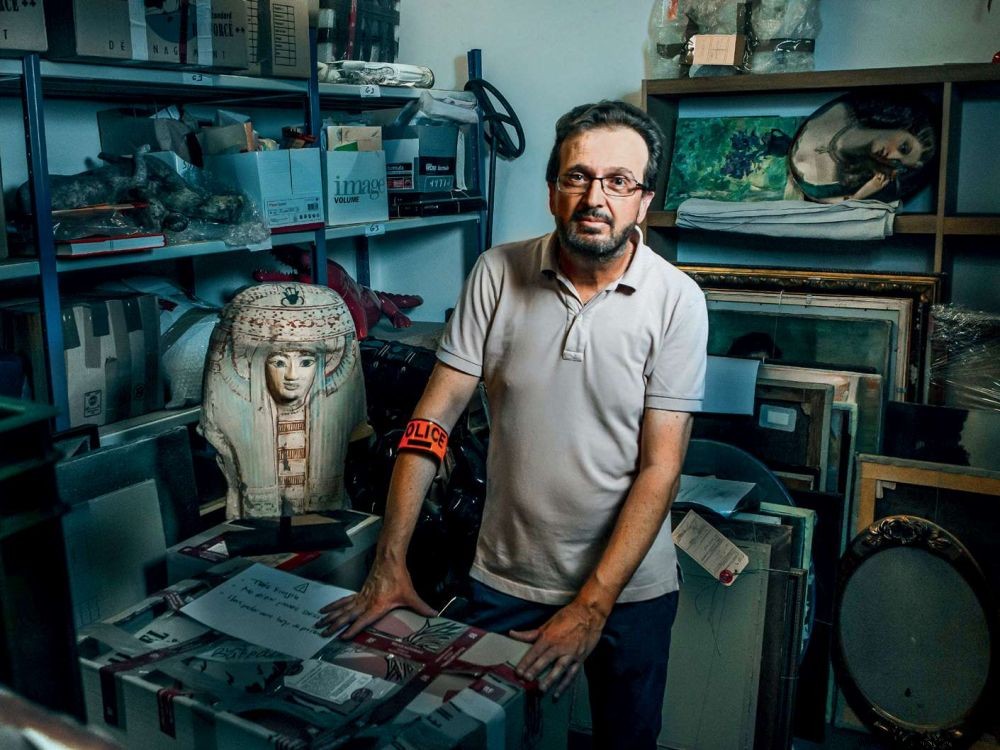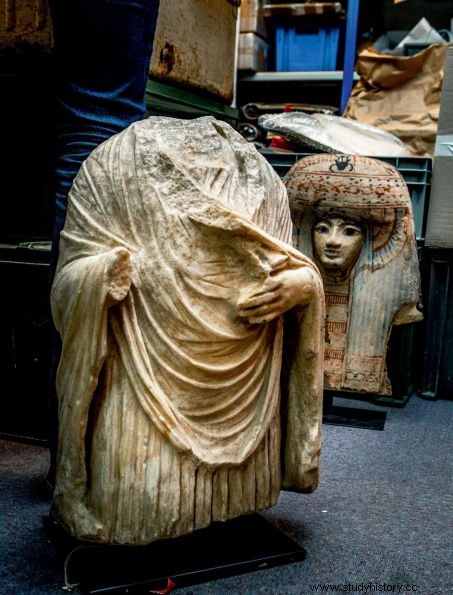The Central Office for the Fight against Trafficking in Cultural Goods exceptionally opened its doors to us in Nanterre, near Paris. Diving into the heart of very sensitive investigations.

Police Commander Jean-Luc Boyer, deputy head of the OCBC, in the room that houses cultural property recently found during investigations. The market for stolen works of art is the 3rd largest illegal trade in the world after narcotics and weapons (United Nations Office on Drugs and Crime).
This article is taken from the monthly n°884 of Sciences et Avenir-La Recherche, dated October 2020.
A motley collection of deformed straw hats and old-fashioned postcards. It is on this astonishing decor that you come to the second floor of the building which houses the offices of the Central Office for the Fight against Trafficking in Cultural Property (OCBC) in Nanterre. "We collect the ugliest things! It relaxes us!" , smiles Captain Jean-Luc Boyer, number two of this very special service, in front of this assembly of kitsch objects, a far cry from the virgins of the 17th century, Chinese or Egyptian antiquities and master paintings that his teams are looking for daily! Welcome to one of the most discreet police departments in France, which is celebrating its 45th anniversary this year.
Meeting the police officers of the OCBC - a special service of the Central Directorate of the Judicial Police - is not an easy task. Months of negotiations were needed to lift the veil on the work of these 25 officials - including 15 investigators - whose targets are the theft of cultural property and all associated offences:concealment, trafficking in works of art and of antiques. It is precisely in the very hushed circle of Parisian art collectors and antique dealers that their last resounding crackdown took place:five people were arrested, suspected of participating in a vast traffic in antiquities from unstable countries. Near and Middle East (see box below). The OCBC was established in 1975, as the Central Office for the Suppression of theft of Works and Objects of Art, at a time when thefts from churches, stimulated by an international market for flourishing religious art, were expanding rapidly. "In the 1970s and 1980s, we had to deal with 15,000 to 20,000 thefts a year! remembers Jean-Luc Boyer . These thefts were committed by organized gangs, in particular two Belgian and Italian networks then sponsored by the Sicilian mafia. We have managed to almost dry up this clandestine market by arresting the biggest fences. In 2019, flights fell below 2,000 per year in France." Half from the gendarmerie and the national police, its investigators can intervene throughout the territory, overseas, but also abroad, when the investigations require it to lend assistance to local investigators. "Thefts of cultural property follow specific procedures and we are co-seized for these particular cases by the investigating magistrates in order to support the local branches of the judicial police" , explains Jean-Luc Boyer. The information collected is immediately integrated into the police and gendarmerie files, starting with the specialized database of the OCBC, Treima, and transferred to that of Interpol, Psyché. Treima (Thesaurus of electronic research and imagery in artistic matters) is a digitized photo library where all the stolen objects are grouped. Precise description of the missing work, victim file... everything is recorded. In total, Treima has more than 10,000 references, including those of the royal medallions recently stolen from the National Library of France in Paris or those of around a hundred objects (statuettes and jewellery) including the disappearance of a renowned museum located on the edge of the Seine was discovered during a verification (ten-year control of the collections) and for which the institution lodged a complaint in 2018. Or this crown decorated with precious stones stolen in 2017 from a cathedral in central France...
This article is taken from the monthly n°884 of Sciences et Avenir-La Recherche, dated October 2020.
A motley collection of deformed straw hats and old-fashioned postcards. It is on this astonishing decor that you come to the second floor of the building which houses the offices of the Central Office for the Fight against Trafficking in Cultural Property (OCBC) in Nanterre. "We collect the ugliest things! It relaxes us!" , smiles Captain Jean-Luc Boyer, number two of this very special service, in front of this assembly of kitsch objects, a far cry from the virgins of the 17th century, Chinese or Egyptian antiquities and master paintings that his teams are looking for daily! Welcome to one of the most discreet police departments in France, which is celebrating its 45th anniversary this year.
Meeting the police officers of the OCBC - a special service of the Central Directorate of the Judicial Police - is not an easy task. Months of negotiations were needed to lift the veil on the work of these 25 officials - including 15 investigators - whose targets are the theft of cultural property and all associated offences:concealment, trafficking in works of art and of antiques. It is precisely in the very hushed circle of Parisian art collectors and antique dealers that their last resounding crackdown took place:five people were arrested, suspected of participating in a vast traffic in antiquities from unstable countries. Near and Middle East (see box below). The OCBC was established in 1975, as the Central Office for the Suppression of theft of Works and Objects of Art, at a time when thefts from churches, stimulated by an international market for flourishing religious art, were expanding rapidly. "In the 1970s and 1980s, we had to deal with 15,000 to 20,000 thefts a year! remembers Jean-Luc Boyer . These thefts were committed by organized gangs, in particular two Belgian and Italian networks then sponsored by the Sicilian mafia. We have managed to almost dry up this clandestine market by arresting the biggest fences. In 2019, flights fell below 2,000 per year in France." Half of them from the gendarmerie and the national police, these investigators can intervene throughout the territory, overseas, but also abroad, when the investigations require it to lend assistance to local investigators. "Thefts of cultural property follow specific procedures and we are co-seized for these particular cases by the investigating magistrates in order to support the local branches of the judicial police" , explains Jean-Luc Boyer. The information collected is immediately integrated into the police and gendarmerie files, starting with the specialized database of the OCBC, Treima, and transferred to that of Interpol, Psyché. Treima (Thesaurus of electronic research and imagery in artistic matters) is a digitized photo library where all the stolen objects are grouped. Precise description of the missing work, victim file... everything is recorded. In total, Treima has more than 10,000 references, including those of the royal medallions recently stolen from the National Library of France in Paris or those of around a hundred objects (statuettes and jewellery) including the disappearance of a renowned museum located on the edge of the Seine was discovered during a verification (ten-year control of the collections) and for which the institution lodged a complaint in 2018. Or this crown decorated with precious stones stolen in 2017 from a cathedral in central France...
Blood Antiquities
The illegal importation of objects from war zones in the Near and Middle East is of particular concern to OCBC investigators. Available figures show more than 15,000 antiquities looted in Iraq, either from museums or from archaeological sites. According to the United Nations Office on Drugs and Crime, this traffic would rank 3rd among illicit trade in the world for a value of 3.1 to 5.7 billion euros. The flow of loot can take decades. Some objects looted in 2003 thus arrived on Western markets ten to fifteen years later. Part of the product of the plunder of the terrorist group Daech would thus sleep in the free ports of Singapore, Hong Kong or Geneva, sheltered from customs controls, and could be sold by 2030. Free ports in which, discovered the police, "auctions take place without the coins ever leaving where not even seen by buyers!" , confirming that cultural goods could be vehicles for money laundering. Enormous sums are thus recycled through the purchase of works of art, which, through sales and resales, end up being legalized and certified.

This sculpture illegally imported from Cyrenaica (Libya) was recently seized by the OCBC.
Make cross-checks according to the operating methods
The list of valuable missing items is painfully long. "Treima allows us to cross-check operating methods. A special office, that of Judicial Processing and Statistics, goes through and cross-checks all these procedures" , explains Marine C., a member of the service who also works with other bases such as Mérimée - for architectural heritage - and Palissy - for movable heritage. "Any object displayed in these databases then becomes legally unsaleable, which constitutes a major obstacle to looting" , explains Alain H., one of his colleagues. And if the goal of all these efforts is of course to find the stolen works, they also aim to prevent new crimes, through security audits carried out by these specialists at the museums.

OCBC's Treima and Interpol's Psyche databases list more than 50,000 stolen objects with their detailed description or photo.
However, the percentage of elucidation of cases leads the police to remain humble. "Across all surveys, the resolution rate is 5%" , recognizes Jean-Luc Boyer. Investigators found, for example, a priceless Rembrandt stolen from the Draguignan museum in 1999.
But criminals know that thefts of cultural property - with the exception of those belonging to the state - are time-barred "from the first bona fide holder" , in other words the first individual or gallery owner who can produce an invoice attesting to said good faith. We then speak of "acquisitive prescription" and under article 2276 of the civil code which specifies "that in fact of furniture, possession is worth title" , the holder of the object is deemed to be its owner without the need for title. "Even if the previous owner can prove that the object in question belonged to him, there is nothing more he can do" , explains Jean-Luc Boyer. "On the other hand, he specifies, concealment is a continuous offense. If a person is intercepted with a stolen work of art, the facts are not time-barred." The whole market is thus divided between "good" and "bad" faith holders. For a simple theft, the penalty incurred is three years in prison, against seven years for that of a national treasure. But, in all cases, if the object has not been found after six years, the facts are time-barred, again with the exception of national property for which time-bar does not exist. "All of this is cumbersome to manage because it is up to the investigators or the magistrates to establish the evidence of bad faith" , admits the co-responsible of the OCBC.
Counterfeiting and "targeting" on the rise
The police now face two formidable new adversaries, in constant progression:counterfeiting and "targeting". The first floods museums and galleries from New York to Shanghai, ranging from fake Brueghels to mass-produced bronzes. The second refers to the theft of specific works by international teams answering to sponsors. For the OCBC, the parade would be to improve the monitoring of works of art in order to know their history and journey within the art market and museum institutions. An endless race.
Photos:Julien Faure/Leextra for Sciences et Avenir
